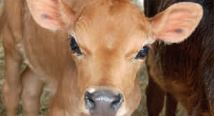



Biosecurity at Calving is Protecting Calf Health
Poultry and swine operations tend to limit the number of visitors on operations and reduce the number of people in contact of livestock.This is the message of dairy science master's student Alyssa Dietrich at Virginia Cooperative Extension who stresses that any farm benefits from reduced disease transfer through biosecurity.

The immune system of the neonatal calf is naïve, meaning she is highly vulnerable to disease, writes Alyssa who is studying with R.E James, extension dairy scientist in Virginia.
Because of this, biosecurity practices are especially important to prevent disease transfer to calves.
Pathogens can be spread to calves from sources within the operation or from the outside-in. From within an operation, calves may be exposed to pathogens from other calves by physical contact or unclean equipment used for feeding and treating.
*
"Most commercial poultry or swine operations limit access to a very small number of people who wear clean boots and coveralls."
Employees that work with older animals also may spread disease to the young calves on their clothing or hands. People outside of the operation, such as veterinarians, salespeople, and other visitors may carry pathogens on their clothes or hands that can spread to calves. To boost the integrity of your biosecurity practices, remember that cleanliness is critical. Identify all things calves come in contact with, and keep them clean!
Maintain a well-bedded maternity pen to ensure that calves are exposed to the lowest pathogen load possible in the first hours of life. Calves should enter clean hutches or group pens bedded using clean equipment.
If possible, clean hutches or pens with a disinfectant after weaned calves leave, and keep them empty for a few days before new calves enter. It is also important to feed and treat calves with clean equipment and washed hands.
Always wash bottles, nipples, buckets, and tube feeders after feeding. Rinse with lukewarm water, then wash in hot water detergent and bleach, and rinse with an acid sanitizer and drain. If using the same equipment for multiple calves during feeding, nipples or buckets should be disinfected between calves with chlorhexidine.
When treating calves, use sterile needles and washed and disinfected balling guns, esophageal feeders, etc. Cleaning protocols should be posted where liquid feed and treatments are prepared to remind employees of these procedures.
Another way to protect your calves is to limit the number of people that come in contact with calves. Other livestock industries have practiced this for quite some time.
Most commercial poultry or swine operations limit access to a very small number of people who wear clean boots and coveralls. Now think of all the people that have access to animals on a dairy: employees, veterinarians, salespeople, visitors, etc.
Do they all practice proper biosecurity protocols? Posting restricted access signs at the farm entrance or by the calves may help. However, it is also important to discuss calf biosecurity with your visitors.
If visitors need access to the calves, make sure that they visit the calves before older animals, and that they have clean boots and hands. The key to designing sound biosecurity protocols is to limit calf contact with potential pathogen carriers. Any thing or person that must contact the calf should be free of contaminants to reduce the risk of disease transfer to calves.


